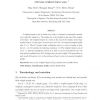721 search results - page 12 / 145 » Graphs with Large Obstacle Numbers |
DAGSTUHL
2006
13 years 11 months ago
2006
It is known that, for every constant k 3, the presence of a k-clique (a complete subgraph on k vertices) in an n-vertex graph cannot be detected by a monotone boolean circuit usi...
DM
2008
13 years 9 months ago
2008
A weighted graph is one in which every edge e is assigned a nonnegative number w(e), called the weight of e. The weight of a cycle is defined as the sum of the weights of its edge...
STACS
2010
Springer
14 years 4 months ago
2010
Springer
Abstract. A Boolean function on N variables is called evasive if its decision-tree complexity is N. A sequence Bn of Boolean functions is eventually evasive if Bn is evasive for al...
ADHOCNOW
2004
Springer
14 years 3 months ago
2004
Springer
Topology control is the problem of assigning transmission power values to the nodes of an ad hoc network so that the induced graph satisfies some specified property. The most fun...
GD
2004
Springer
14 years 3 months ago
2004
Springer
Large graphs are difficult to browse and to visually explore. This note adds up evidence that some graph drawing techniques, which produce readable layouts when applied to medium-s...

